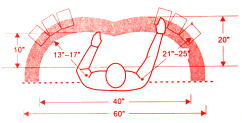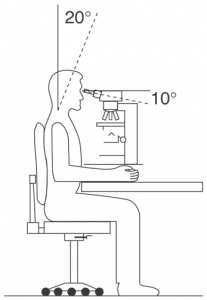Click on the tabs below for suggestions, and use this laboratory ergonomics self-evaluation checklist (from Washington University) to help you arrange you lab spaces.
- Take short breaks every 20 minutes to reduce joint strain and muscle fatigue. Do this even if you are “comfortable” because it will help reduce the potential effects caused by repetitive motions, etc.
- Keep frequently used items within close reach. Most frequently used
 items should beat approximately a forearm’s reach away, with lesser-used items up to arm’s reach away. Items you are currently working with should be directly in front of the body.
items should beat approximately a forearm’s reach away, with lesser-used items up to arm’s reach away. Items you are currently working with should be directly in front of the body. - Maintain an upright posture. Adjust the position of your work, your work surface, and your chair to avoid leaning or hunching over, or having to stretch while reaching.
- Work Surface Height.
- For precision work, adjust (if possible) the work surface height or your chair to bring the work closer to you.
- For regular light work, the work surface should be around elbow height or just below.
- For heavy work, the work surface should be approximately six inches below elbow height.
- Chair Posture.
- When sitting, sit against the back of your chair. If your feet come off the ground, lower the chair or use the foot ring. Try to work at a bench cut or space with adequate knee clearance; you need room for your legs.
- Arms & Torso.
- Keep shoulders, arms and hands relaxed and elbows close to the sides while working; do not work with “winged” elbows.
- Try to keep the wrists neutral (straight) and aligned while working. Sitting/standing close to your work will help with this.
- Avoid elevating arms and elbows above shoulder for lengthy periods to prevent static work of arm, and shoulder strain.
- Make sure all equipment is clean and in good working order to help minimize forceful twisting, turning, and pinching. Equipment should be the right size for your hand. Use padding and/or tubing on equipment and work area edges to reduce pressure and force while working.
- Use the lightest pressure possible to hold or operate your equipment (e.g. pipettes). Use electronic, automated, or light touch model equipment when possible.
- Remember to vary your tasks or take frequent short breaks (e.g., ≥ 2 minutes for every 20 minutes of pipetting).
- Alternate your grip on items like forceps and pipetting if possible.
- Intensive tasks should be spread through the day or shared between employees when possible.
- Ensure proper lighting for your task.
- Store heavy items on lower shelves.
- Use bottle dispensers and bottom dispensing carboys for dispensing liquids.
This laboratory procedure is highly repetitive and involves a variety of risk factors. Cumulative Trauma Disorders (CTD) or Musculoskelatal Disorders (MSDs) may occur when a laboratory worker pipettes for two hours a day or longer on a continuous basis.
Associated Risk Factors:
- Repetitive motion of the hands, forearm and thumb, or fingers
- Pinch grip when handling pipette tips, or opening vials
- Bending and twisting of the wrist
- Working with “winged” elbows (elbow held at an elevated position away from the body)
- Neck bent forward or to the side and/or jutted chin
- Awkward and static postures
- Excessive force of the thumb
- Overreaching
- Standing for long periods of time
Preventive Measures:
- Adjust height and position of sample holders, solution container, and waste receptacle to prevent twisting and bending of wrist, neck and rolled shoulders.
- Use low profile waste receptacles for used tips. These ideally should be no higher than the top of the tubes being filled.
- Hold the pipetter with a relaxed grip.
- Use minimal pressure while pipetting.
- Use electronic pipettes for highly repetitive pipetting tasks to reduce/eliminate contact pressure on thumb.
- Rotate pipetting tasks among several people as another way to reduce the impact of risk factor associated with pipetting.
- Watch this Pipetting Safety and Ergonomics video (UCLA) for visual examples.
Working in fume hoods or other safety cabinets tempt laboratory personnel to assume a variety of awkward postures due to limited work access, which restrict arm movement, and therefore significantly increase the amount of stress on joints of the upper limbs, neck, and back.
Associated Risk Factors:
- Repetitive motions of the hands, wrist, and forearms, especially when pipetting is involved
- Constrained knee and leg space, especially in fume hoods and older BSCs
- Contact pressure on the forearms, wrists and knees, or legs
- Awkward and static posture of the neck, torso, legs, arms and wrists
- Constrained body position, overloading muscles, tendons, and joints in asymmetrical manner
- Working with elbows winged
- Overreaching
- Prolonged standing in unnatural positions or in restricted postures
Preventive Measures:
-
- Perform your work at least six inches back into the hood or safety cabinet to maintain optimal airflow containment for material and personal protection.
- Keep the sash clean and free of glare so that you can see without tilting your neck or assuming an awkward position.
- Make sure cabinet lighting is working properly; good and proper lighting help reduces eye strain.
- Keep the work area clean and free of clutter. Remove unnecessary supplies.
- Avoid contact pressure (forearm and wrists contact with sharp edges).
Operating a microscope for long hours puts much strain on the neck, shoulders, eyes, lower back, and arms/wrists.
Associated Risk Factors:
- Awkward and static posture of the lower back
- Lack of adequate leg and knee clearance under work table
- Working with elbows winged
- Pinch grip when adjusting binocular eyepiece
- Wrist and palm contact pressure in the carpal tunnel area
- High repetition
- Eye strain and fatigue
- Awkward and static posture of the neck and head
Preventive Measures:
- Ensure that you can view the eyepiece while sitting or standing in such a way to maintain proper head and neck neutral (upright) posture;Avoid raising shoulders and bending neck while looking through microscope’s eyepiece. Accomplish this by adjusting your chair (if applicable), the work surface, and/or the microscope eyepiece. An angle stand or extendable eye tube may be available to aid in adjustment.
- Position microscope as close as possible towards you to ensure upright head position (this usually means it is pulled to the edge of the workbench).
- Arms should be supported and relaxed while using the microscope with the elbows close to the sides. Pad sharp edges with foam, or pad wrists and forearms to reduce pressure.
- Keep scopes repaired and clean for easier use, and use lighting of proper intensity.
- Keep elbows close to sides, below 45 degree angle.
- Make sure to work with wrists in neutral (straight) position.
- Make sure leg and knee clearance under work bench is adequate.
- Prevent repetition, and alter prolonged awkward posture. Take adequate small breaks, or perform other job tasks that requires less repetition, rest your eyes, neck, and shoulders.
- Use a video display terminal, when appropriate, to view sample and reduce eye and neck strain.
Manual rotary microtome use in histology laboratories requires performing many repetitive functions. In the course of one day a person may use between 40 and 50 cassettes or blocks, hence turning the microtome wheel for at least a 1000 times. This is not only repetitive work, but turning microtome’s wheel also requires force or forceful exertion. Other repetitive microtome-related functions such as replacement of specimens and use of trimming wheel increase the probability of acquiring MSDs.
Preventive Measures:
- Place microtome on appropriate workbench (appropriate height). Take into consideration the way work will be performed (standing or sitting). Ensure that the microtome can be operated in an upright position with back, shoulders, and neck in neutral positions.
- If sitting is required, make sure the workbench allows enough clearance for leg and thighs.
- Use only adjustable chair or stool with built-in foot rest.
- Make sure sharp edges are not an issue.
- Protect wrists and forearms from contact pressure. Pad sharp edges.
- Use as little force as possible when turning the handwheel.
- Take frequent small breaks from microtome work every 20 minutes.

You must be logged in to post a comment.